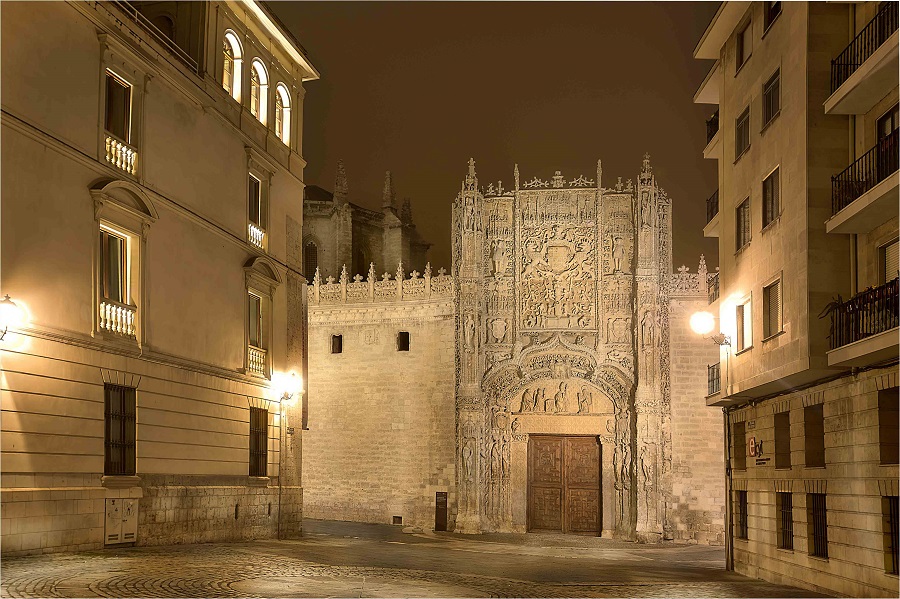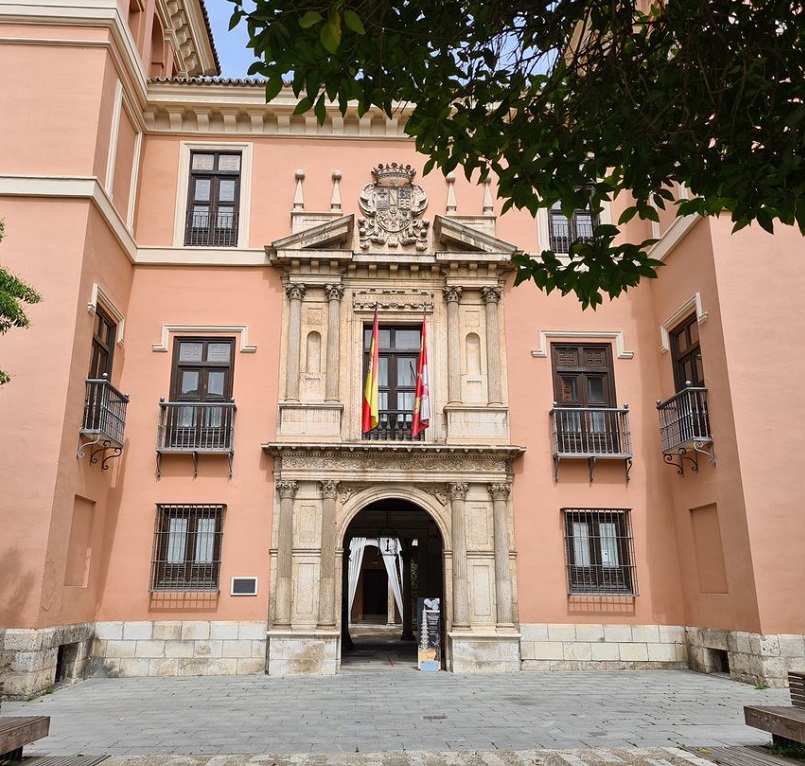Lugares -monumentos - Palacio de Fabio Nelli
Breadcrumb
Breadcrumbs
Asset Publisher
Seminary School of Saint Gregory

Discover its enigmatic façade
It is an architectural work from the end of the 15th Century, under the guidance of Fray Alonso de Burgos, confessor of the Catholic Monarchs and Bishop of Palencia.
Its monumental façade replete with decorative and sculptured elements attributed to Gil de Silóe is worth noting. With Fray Alonso before the Pope in the tympanum and St. Dominic and St. Paul at the sides.
The buttresses are decorated with warriors. There are also angels with the armorial bearings of the founder. In the centre piece there is a pomegranate tree sheltering the arms of the Catholic Monarchs with a pomegranate in the top representing their conquer (so it is dated after 1492).
The design of the chapel, where the bishop is buried, is attributed to the architects Juan Guas and Juan de Talavera, starting in 1484. In 1499 a sacristy by Simón de Colonia was attached to it. Now it is state property and houses since 1933 the National Scultpture Museum.
Navigation Menu
Asset Publisher
Calle San Ignacio, 17
Asset Publisher
LOCATION
Widget tiempo Valladolid
Media Gallery
Valladolid seen through the eyes of its inhabitants and tourists
FabioNelli1.jpg
FabioNelli1.jpgFabioNelli2.jpg
FabioNelli2.jpgFabioNelli3.jpg
FabioNelli3.jpgFabioNelli4.jpg
FabioNelli4.jpgFabioNelli5.jpg
FabioNelli5.jpgFabioNelli6.jpg
FabioNelli6.jpgFabioNelli7.jpg
FabioNelli7.jpgFabioNelli8.jpg
FabioNelli8.jpgFabioNelli9.jpg
FabioNelli9.jpgFabioNelli1.jpg
FabioNelli1.jpgFabioNelli2.jpg
FabioNelli2.jpgFabioNelli3.jpg
FabioNelli3.jpgFabioNelli4.jpg
FabioNelli4.jpgFabioNelli5.jpg
FabioNelli5.jpgFabioNelli6.jpg
FabioNelli6.jpgFabioNelli7.jpg
FabioNelli7.jpgFabioNelli8.jpg
FabioNelli8.jpgFabioNelli9.jpg
FabioNelli9.jpgAsset Publisher
Palace of Fabio Nelli

Symbol of power, wealth and culture
This palace is a symbol of the power, wealth and culture of its owner, a banker from Valladolid of Italian descent, Fabio Nelli de Espinosa. It is a beautiful and excellent example of classicist architecture in Valladolid. Juan González de la Lastra began its construction in 1576. The front of the building, a work by Pedro de Mazuecos in 1595, has Plateresque elements and introduces elements of Italian inspiration: symmetric facade with two towers and a central door. The coat of arms of the Marquis de la Vega, the owner of the palace, was later added to the facade. The staircase was designed by Pedro de la Maza. In the realization of the project, both artists experimented with new architectural principles that led to classicism, with special mention given to the central patio and entrance protected by towers on each side. In 1967 the building was completely restored to house the Archaeological and Fine Arts collection of the Provincial Museum of Archaeology, now called the Museum of Valladolid.
Juan González de la Lastra elabora los planos en 1576. La portada, obra de Pedro de Mazuecos en 1595, tiene motivos platerescos e introduce elementos de inspiración italiana: fachada simétrica con dos torres y acceso en el centro en línea con la entrada al patio. Las pretensiones del rico banquero quedaron plasmadas en el arco del triunfo romano que acoge la fachada, símbolo de poder, y en los motivos que representan la riqueza de su linaje (angelillos victoriosos, cestos con fruta, el dios del vino Baco o una máscara al gusto italiano). Sobre la portada se grabó la enigmática inscripción ‘Soli deo honor et gloria’ (Solo a Dios honor y gloria)Posteriormente se añadirá el escudo del Marqués de la Vega, propietario del palacio y nieto de Fabio Nelli.
La escalera fue diseñada por Pedro de la Maza. En su ejecución, los artistas experimentaron los nuevos principios arquitectónicos que conducen al clasicismo, destacando el patio interior, de columnas en tres de sus lados, la escalera principal y la portada enmarcada por dos torreones.
En 1967 se restauró el edificio para albergar las colecciones de Arqueología y Bellas Artes del Museo Arqueológico Provincial, hoy Museo de Valladolid.
